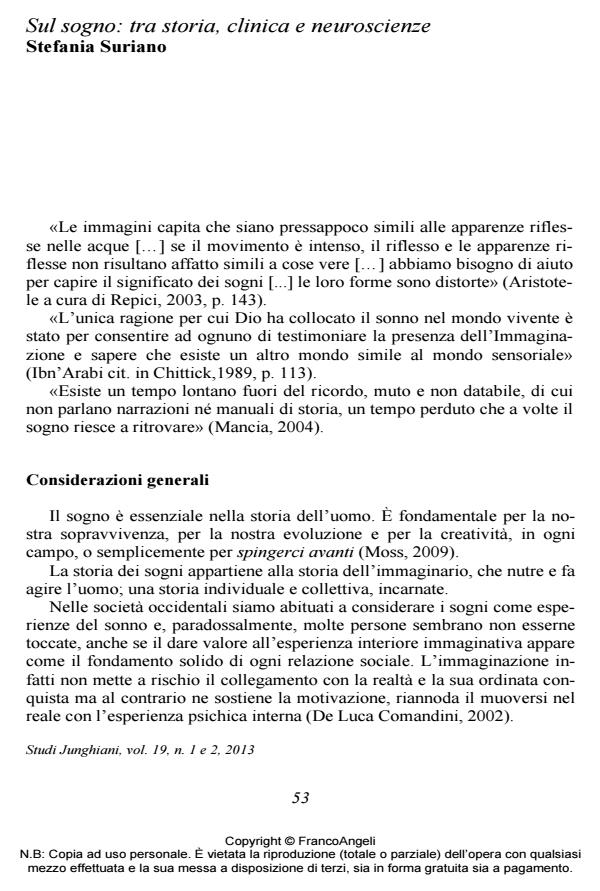Sul sogno: tra storia, clinica e neuroscienze
Titolo Rivista STUDI JUNGHIANI
Autori/Curatori Stefania Suriano
Anno di pubblicazione 2014 Fascicolo 2013/37-38
Lingua Italiano Numero pagine 27 P. 53-79 Dimensione file 788 KB
DOI 10.3280/JUN2013-037004
Il DOI è il codice a barre della proprietà intellettuale: per saperne di più
clicca qui
Qui sotto puoi vedere in anteprima la prima pagina di questo articolo.
Se questo articolo ti interessa, lo puoi acquistare (e scaricare in formato pdf) seguendo le facili indicazioni per acquistare il download credit. Acquista Download Credits per scaricare questo Articolo in formato PDF

FrancoAngeli è membro della Publishers International Linking Association, Inc (PILA)associazione indipendente e non profit per facilitare (attraverso i servizi tecnologici implementati da CrossRef.org) l’accesso degli studiosi ai contenuti digitali nelle pubblicazioni professionali e scientifiche
La storia della psicoanalisi è indissolubilmente legata allo studio dei sogni. Nella storia dell’uomo il sogno unisce mondi opposti: quello della veglia e del sonno, della coscienza e dell’inconscio, della ragione e del desiderio. Importante nell’antichità, dimenticato nell’occidente razionalista del XIX secolo, il sogno è stato rivalutato dalla psicoanalisi come via di accesso all’inconscio e a quella psicologia del profondo che ha rivoluzionato l’idea di un comportamento guidato esclusivamente da una coscienza razionale. Se Freud attraverso l’interpretazione traduce il linguaggio immaginifico del sogno nel linguaggio dell’Io e della veglia secondo un’idea di cura unidirezionale, fondata sulla progressiva conquista dell’Es da parte dell’Io; nel pensiero junghiano il lavoro sui sogni si colloca all’interno dell’esigenza, che la natura pone, di una coscienza più ampia ed equilibrata, nonché all’interno di un processo che si articola in un dialogo continuo tra coscienza e inconscio, rappresentabile come una struttura ciclica a spirale. Per Freud le immagini del sogno hanno valore di segni, corrispondono a concetti. Per Jung le immagini del sogno non vanno considerate nel loro contenuto letterale ma per quello simbolico. La circumambulazione e l’amplificazione consentono un dialogo tra stati di veglia e stati di sogno all’interno di una relazione affettiva condivisa, rendendo possibile il potenziale collegamento di stati del Sé disgiunti, senza voce, non ascoltati, esito spesso di esperienze traumatiche dissociative. Il caso clinico descrive il processo condiviso di costruzione del significato simbolico del sogno. La centralità dell’immagine nell’elaborazione teorica junghiana è evidente sia nella teoria, sia nella tecnica. Le intuizioni di Jung sul funzionamento psichico come percezione interiore, per immagini dei processi del corpo, portano a concludere che una distinzione (quella tra corpo e psiche) è un procedimento intellettivo intrapreso allo scopo di acquisire conoscenza di un medesimo fatto in due visuali. Una visione attuale, confermata dalle neuroscienze, tanto che nella medicina del XXI secolo, la guarigione immaginale sta acquisendo un ruolo cruciale in un nuovo approccio alla salute, contraddistinto dalla forza sanante del racconto e dal potere dei sogni.
Parole chiave:Sogno, inconscio, immagine, circumambulare, amplificazione, neuroscienze
Stefania Suriano, Sul sogno: tra storia, clinica e neuroscienze in "STUDI JUNGHIANI" 37-38/2013, pp 53-79, DOI: 10.3280/JUN2013-037004